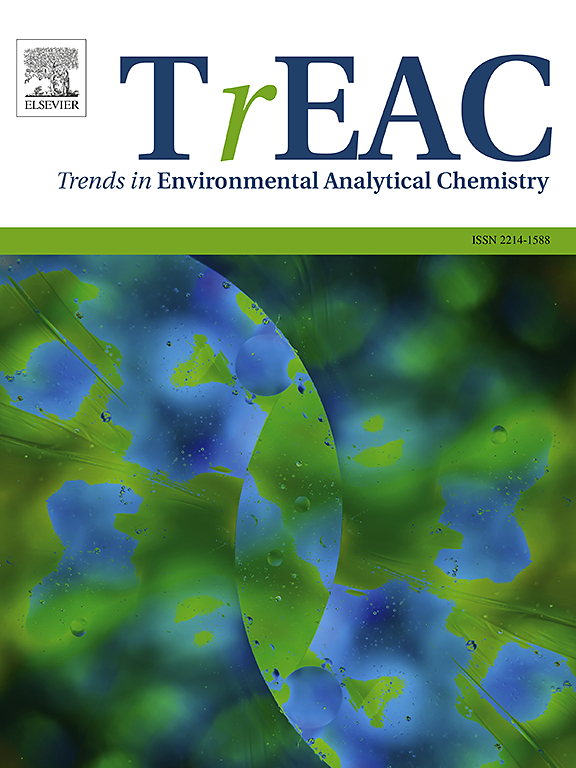铜基纳米酶在环境分析中的应用综述
IF 13.4
2区 化学
Q1 CHEMISTRY, ANALYTICAL
引用次数: 0
摘要
污染物的分析和检测是解决环境问题的重要步骤之一。天然酶作为生物体内产生的高效催化剂,可以通过其介导的酶促反应来检测和感知污染物。然而,天然酶的环境稳定性差、纯化技术复杂、成本高,限制了其在环境分析中的大规模应用。纳米酶是一类具有类酶活性的纳米材料,具有催化活性高、稳定性好、成本低、易于生产和制备等特点。大多数纳米酶使用过渡金属作为催化活性位点。由于铜具有多种氧化态,以铜为活性中心的纳米酶通常表现出多种活性,特别是一些具有类似氧化酶活性的铜基纳米酶,其催化作用依赖于氧。这一特点使其在环境分析(例如,快速检测和识别环境污染物)中得到更广泛的应用。本文以近三年来分析环境污染物的铜基纳米酶的研究为基础,综述了铜基纳米酶类酶活性的分类、设计策略、组成类型及其在环境分析(快速检测和识别环境污染物)领域的各种应用。总结了铜基纳米酶在环境分析中的现状(检测和识别环境污染物的有效性)、挑战(灵敏度低、选择性差、缺乏合理设计)和未来趋势(与电催化、分子印迹技术的结合、基于目标物质特性的合理设计)。我们将铜基纳米酶的活性与其相应的设计策略联系起来,并讨论了产生具有一系列活性的铜基纳米酶的方法。综述了靶物质与铜基纳米酶信号输出之间的相互作用。我们相信这将促进铜基纳米酶在环境分析中的实际应用的进一步发展。本文章由计算机程序翻译,如有差异,请以英文原文为准。
Copper-based nanozymes for environmental analytical applications: A review
The analysis and detection of pollutants is one of the important steps in solving environmental problems. Natural enzymes, as efficient catalysts produced in living organisms, can be applied to the detection and sensing of pollutants through their mediated enzymatic reactions. However, the poor environmental stability, complex purification techniques, and high costs of natural enzymes have limited their large-scale application in environmental analysis. Nanozymes, as a class of nanomaterials with enzyme-like activity, are characterized by high catalytic activity, good stability, low cost, and easy production and preparation. Most nanozymes use transition metals as catalytic active sites. Since copper has multiple oxidation states, nanozymes with copper as the active center typically exhibit multiple activities, particularly some copper-based nanozymes that possess oxidase-like activity, whose catalytic action relies on oxygen. This characteristic has enabled their broader application in environmental analysis (e.g., rapid detection and identification of environmental pollutants). This review discusses the classification of enzyme-like activities of copper-based nanozymes and their design strategies, composition types, and various applications in the field of environmental analysis (rapid detection and identification of environmental pollutants) based mainly on the research of copper-based nanozymes for the analysis of environmental pollutants in the last three years, and summarizes the current status of copper-based nanozymes in environmental analysis (their effectiveness in detecting and identifying environmental pollutants), challenges (low sensitivity, poor selectivity, lack of rational design), and future trends (integration with electrocatalysis, molecular imprinting technology, and rational design based on target substance characteristics). We link the activity of copper-based nanozymes with their corresponding design strategies and discuss approaches to yield copper-based nanozymes with a range of activities. The interactions between the target substances and the signal output generated by copper-based nanozymes are summarized. We believe this will facilitate the further development of practical applications for copper-based nanozymes in environmental analysis.
求助全文
通过发布文献求助,成功后即可免费获取论文全文。
去求助
来源期刊

Trends in Environmental Analytical Chemistry
Chemistry-Analytical Chemistry
CiteScore
21.20
自引率
2.70%
发文量
34
审稿时长
44 days
期刊介绍:
Trends in Environmental Analytical Chemistry is an authoritative journal that focuses on the dynamic field of environmental analytical chemistry. It aims to deliver concise yet insightful overviews of the latest advancements in this field. By acquiring high-quality chemical data and effectively interpreting it, we can deepen our understanding of the environment. TrEAC is committed to keeping up with the fast-paced nature of environmental analytical chemistry by providing timely coverage of innovative analytical methods used in studying environmentally relevant substances and addressing related issues.
 求助内容:
求助内容: 应助结果提醒方式:
应助结果提醒方式:


